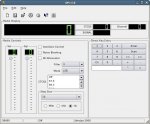Hi, wow! Thanks for the reply.
The line-in should be on (the mic wasn't, I had to fiddle to get that working - all 3(?) inputs were just labeled 'record', so I turned them all on).
I could hear the signal whilst recording, which was very handy as you suggest.
USB is ‘Upper Side Band’ and it is amplitude demodulation vs. frequency. You will want to be in FM and will have to retune you receiver when you do. When you hear the satellite signal in USB your carrier frequency is offset low or high from where you want to be in FM. I bet that you are hearing a whistling sound in the background. That is the satellite carrier mixing with the injected carrier in you receiver because of the USB mode of operation.
I've just been reading about USB/LSB/FM etc... on wikipedia, and guess what? You are spot-on with that whistling sound in the background - in fact, it seems to gain in pitch as the satellite approaches and go down in pitch as the satellite is receding. I thought this might be some atmospheric phenomena, but I guess it's 'cos I'm listening to the usb and not the carrier.
So, if you don't mind (like I say, I'm REALLY new to this!) I'd like to just reiterate what I think so far.
I have been listening to the upper side band on 137.620mhz for NOAA17. If I listen on FM (WFM or NFM - I am assuming "Wide" and "Narrow") would the frequency be the same?
The distortion was there even when I listened to the output directly from the scanner using it's internal speaker :-(
However, I do feel really encouraged by this. The USB signal was really clear the last time I recorded it - I tried to upload to my site so I could post a link here, but the resulting WAV file was over 100 meg, so thought that it was probably a bit much.
I must have some setting wrong somewhere and the fact that the USB signal is getting clearer (certainly a lot clearer than my first attempts) leads me to believe that the main FM signal, once I have the settings correct, should be clear too.
Are the USB and LSB picked up on the same frequency? i.e. 137.500 etc...
I like the analogy about the signal from the antenna to the screen.
If I can pick up the USB clearly, does that imply that I have build the antenna more-or-less correctly? This is the only *real* unknown - I have never made an antenna before (short of putting a coat-hanger in my car radio!) and everything else is a proven (I have seen the software produce excellent results on web pages, and have seen websites where the ICOM PCR-1000 has produced excellent results using the same software I am using).
Just for your information, the antenna is just about the highest thing in the village now - our flat is about the highest building in the highest part of the village - even at the roof level (where I can see out of the windows), you can visibly see the horizon in all directions, so there should be little in the way of 'blockages'.




